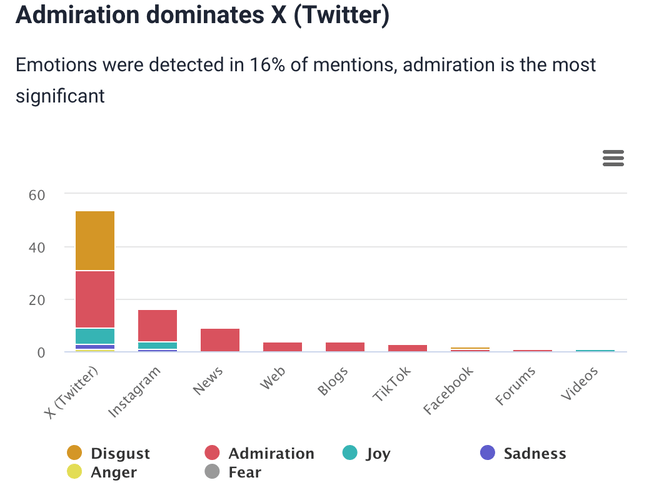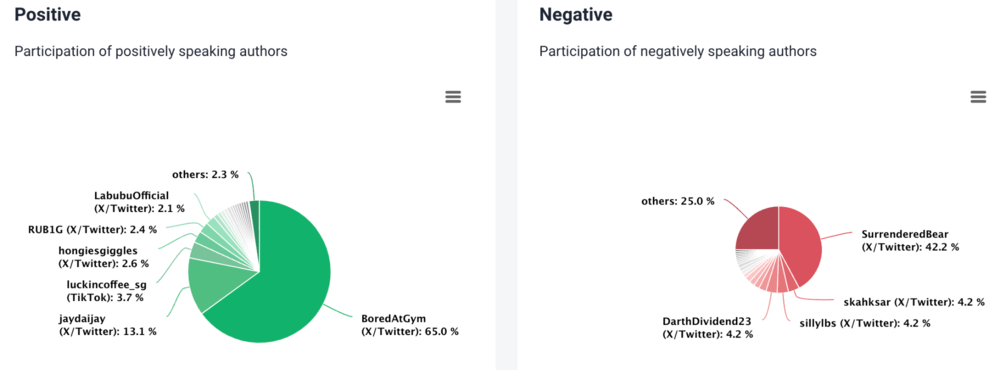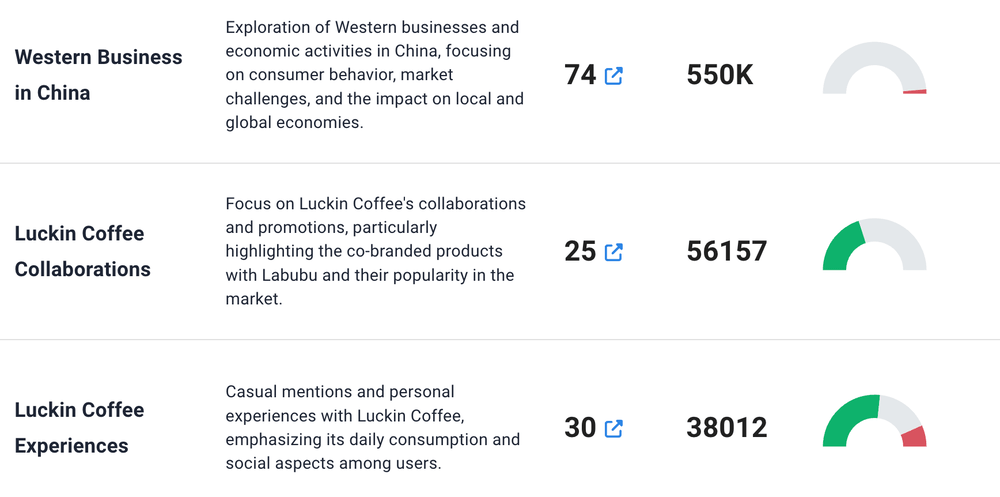Digital Reputation: Strategy, Definition and Tips [Guide for 2026]
Table of contents
In 2020, Luckin Coffee, a promising Chinese challenger to Starbucks, was rocked by a massive scandal. Their CEO fabricated sales figures to inflate the company’s stock price. This news spread quickly and led to Luckin’s delisting from the Nasdaq stock exchange. The scandal destroyed Luckin’s reputation, leading to over 36% negative sentiment.
Digital reputation is the perception of your brand, company, or personal identity through online content. It is shaped by everything from customer reviews, social media activity, and online interactions to search engine results and digital content.
What is a digital reputation? Definition
Your brand’s digital reputation is generally what the search engines say about your brand.
But it’s so much more than just words!
Actual people stay behind those voices and they greatly affect your business online.
Essentially, brand reputation is based on public perception, which influences all actions and interactions related to your personal brand, including:
- Online reviews: Managing negative and positive reviews is crucial for a good digital reputation.
- Activity on social media channels: It can build trust and enhance your brand’s online reputation.
- Customer feedback: Responding to feedback, especially negative comments, can significantly improve perception.
- Content marketing: Creating and sharing valuable content through blogs and articles helps to create an online community.
- Crisis management: Efficiently managing crises is key to your online reputation.
- Website experience: Ensuring your website is user-friendly and ranks well on search engines contributes to a positive digital identity.
Digital reputation shows how people view your business and the value of your products or services. Negative comments on social media can chase customers away.
Good online reputation management can lead to an engaged and loyal online community and business success in the long run.
So, the main goal is to build and maintain a good online reputation. But the question is: how?
How can you quickly check your digital reputation?
Understanding your digital reputation is crucial for maintaining a successful brand.
Luckily, there are media monitoring tools that allow you to analyze public opinion about your online presence quickly.
There are several digital reputation management tools available that specialize in monitoring and analyzing online perceptions. These tools provide immediate insights into your brand’s digital reputation.
For example, Brand24, which is an AI-powered media monitoring tool, offers real-time tracking of your brand’s mentions across the internet.
One of its standout features is the Reputation Score, a numerical value that measures your brand’s level of trust and credibility.
This score ranges from -100, indicating a very negative reputation, to 100, which suggests an excellent reputation.
Why is digital reputation important?
Diving into the world of brand monitoring reveals the complexity of this topic.
Did you know that…
A whole 98% of people read online reviews for local businesses.
It’s time for some honesty. My buying process is usually the same:
- Defining the need
- Research (reviews, features, etc., available online)
- Decision
It’s just three steps, and undoubtedly, the crucial part is “research.” Positive reviews and search engine results greatly impact this buying process.

And you can be sure – I’m not the only one that works that way.
Managing your online reputation takes care of those potential customers’ perceptions and offers some unique benefits.
By monitoring what the internet says about your business or product, you can:
- track trends
- gather customer feedback
- manage negative content
- spot reputational crisis before it escalates
Sooo stay ahead, stay informed, and keep your online reputation glowing!
A well-handled digital reputation can lead to many benefits for your business success, such as:
- boosting your online visibility
- building community
- making your brand more accessible to potential customers
- fostering trust, as customers are likelier to engage with businesses that others have positively reviewed.
Digital reputation strategy
Step 1: Examine your current reputation
The first step in a good digital reputation strategy is understanding your online reputation.
This provides a baseline for measuring progress and improving
How can you check your digital reputation?
Measuring an online reputation can be challenging (if not impossible) without the right social listening tools.
Digital reputation management requires a look into various metrics, including:
- Engagement Rate
- Sentiment
- Brand Mentions
- Search Rankings
- Social Media Growth
- Social media reach
- Non-social reach
AI-powered tools are particularly effective because they can analyze all those metrics at once and provide an answer within a few minutes.
Conduct the Sentiment Analysis of your brand
Here’s my personal story that perfectly explains sentiment analysis importance:
I moved to Cracow a few years ago and clearly remember the first month in a new city. It wasn’t even a week and I already knew about THE BEST ice cream shop in the town – GoodLood.
However, as the company became increasingly popular, many people started to experience enormous lines… and hated it.
Negative reviews flooded the company’s social media channels, and it soon became a real problem.
How to address the issue?
The sentiment analysis would be perfect for that.
By identifying this issue early, GoodLood could implement a more efficient queuing system and introduce a fast-track line for simpler orders.
Analyzing sentiment and mentions with positive and negative feedback helps to detect and address potential crises early, preventing them from escalating.
With Brand24, you can also understand the most negative sources, which can be super helpful for managing reputation:

But you can delve even deeper into mentions of your brand.
For example, the Anomaly Detector feature uses AI to analyze sudden increases in mentions, helping you understand why they occurred.
This understanding is essential for finding the source of negative feedback, which enables you to address issues promptly and proactively to protect your brand.

Benefits of sentiment monitoring include:
- Early PR crisis detection
- More targeted response strategy
- Improved customer experience
- Enhanced brand perception
- Effective resource allocation
Using these tactics, you can maintain a good reputation and quickly fix problems.

Discover emotions around your brand
Sentiment analysis can tell you if people view your company positively or negatively, but emotion analysis digs deeper.
It reveals the specific emotions the audience feels toward the brand. This method shows whether people are:
- Disgusted
- Angry
- Admirable
- Fearful
- Joyful
- Sad
Advanced AI tools help identify which platforms, like social media channels or blogs, spark these emotions.
This insight allows brands to understand and address the root causes of these feelings, helping them connect better with their audience.

Check emojis included in discussions about your brand
Internet users do not always put their emotions into words, so it is important to monitor what emoji they use when describing a brand, company, or product.
How?
You can access this information in Brand24 > Emoji Analysis.

Discover whether influencers talk about your brand in a positive or negative way
Another critical part of your digital reputation is monitoring influencers.
Influencers can significantly impact your brand’s reputation, as seen in 2020 when Kim Kardashian cut ties with Boohoo over sustainability concerns. It resulted in severe backlash and negative press for Boohoo.
So, you definitely get the potential influence of celebrities on brand perception.
But where can I get insights about my influencers? Go to Brand24 > Influencer Analysis.

Take a look at the sentiment of the topics
Every brand sparks discussions on specific topics.
It’s important to monitor which topics are trending and whether the sentiment around them is positive or negative.
Sometimes, even if a brand generally has a good reputation, certain topics can trigger negative conversations.
Just like for Luckin the “Western Business in China”:

Step 2: Build a positive digital reputation
- Positive content
Create and share informative content across your digital platforms and interact respectfully with your audience. - Respond to negative reviews promptly
Address negative feedback quickly and professionally to mitigate potential damage and show your commitment to customer satisfaction. - Collaborate with influencers that align with your brand
Don’t be blinded by the big numbers when choosing people to promote your business. Ensure the influencers you choose share similar values and focus on more positive content. - Engage with your community
Build strong relationships by engaging with followers regularly. Answer questions, participate in discussions, and show appreciation for customer loyalty. - SEO matters!
Optimize your new content with SEO best practices to ensure it reaches the right audience. This includes using relevant keywords, meta descriptions, and alt tags to improve visibility on search engines.
These tips will help you maintain a robust online presence and ensure customers view your brand positively.
Step 3: Monitor your reputation
You should regularly check how your brand is doing online to manage your digital reputation effectively.
After setting up good practices to improve your digital reputation, monitoring the results is important. It is constantly changing, so just the fact that 2 months you were doing incredible – doesn’t mean it’s still that way.
Brand24 offers a useful tool for this.
The Compare Periods feature allows you to set dates and compare your current online sentiment with past data.


The tool shows two lines on a chart: the dark blue line represents your current sentiment trend, and the light blue line shows what it was like before.
Your efforts are paying off if the dark blue line is mostly above the light blue line on the positive sentiment chart.
But if it’s above the light blue line on the negative sentiment chart, it’s a sign you might need to adjust your strategies.
This comparison is a straightforward way to determine whether your brand reputation management is working or needs tweaking.
Step 4: Constantly improve reputation
Remember, if you’re not climbing up the reputation ladder, you might be sliding down it… perhaps on a banana peel! 🍌
Here’s a list of tips to improve your reputation:
- Leverage positive testimonials
Make sure to showcase positive reviews and testimonials on your digital platforms. This will boost potential clients’ confidence in your brand. - Engage on Social Media
Don’t just post and ghost! Engage actively with your audience. Regular interaction can build a community around your brand and make your customers feel valued. - Showcase your brand’s personality
Let your brand’s personality shine through in every interaction. Whether it’s quirky, professional, or down-to-earth, a distinct personality can make your brand memorable and relatable. - Monitor trends and adapt
Keep up with the latest trends in your industry and digital marketing. Being adaptable and current shows that your brand is forward-thinking and ready to evolve, which can attract a modern audience. - Implement transparency
Be transparent about your processes, pricing, and policies. In the digital era, consumers appreciate and trust brands that are open about their operations. - Promote user-generated content (UGC)
Encourage your customers to post their own content related to your brand. It makes you look good and spreads positive vibes naturally.
Conclusion
Managing your digital reputation is a real-life roller coaster.
I’ve seen firsthand how quickly things can go from smooth sailing to a wild ride.
One negative review or viral TikTok can send your reputation into a tailspin. It has ups and downs, and you must keep things on track to ensure your brand thrives.
Final thoughts:
- In today’s world, everyone’s watching. Ignoring your online reputation is like letting go of the controls – it’s bound to get messy.
- A solid digital reputation keeps customers secure and returning for more.
- A tool with AI features will be the best online reputation management software.
- The digital world moves fast, with twists and turns. What worked yesterday might be old news tomorrow. Stay updated and be ready to adjust.
Don’t let your brand go off the rails. Try Brand24 today and take control of your digital reputation!




